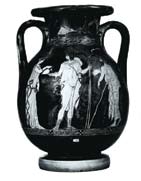
Against all odds,
the Acropolis Hill
(entrance from
Dionysiou Areopagitou
Street) dominates the
Athenian skyline in a remarkable
way. Climbing the 70-metre
Hill, the history of the ancient
city unfolds before you, starting
from Neolithic times, when the
first findings are dated. The first
building you encounter when you
enter is the Propylaia (437-432
B.C.), made from marble of mount
Pendeli to mark the entrance
to the religious complex. At the
southwest is the elegant Temple
of Athena Nike (426-421 BC), of
Ionian order, and further down
the remains of two other temples.
The Erechtheion (421-c405 BC)
is known for its spectacular six
female figures functioning as
columns, the Caryatids. Possibly
named after the women of the
city of Karyes, the originals have
been transferred into the Acropolis
Museum. The Parthenon (447-438
BC), built for virgin (Parthenos)
goddess Athena, was made to
honour her after she won the
city over in a confrontation with
Poseidon. It is built atop an older
temple destroyed by the Persians,
and Athenians spared no expense
in rebuilding this sanctuary of
unrivalled craftsmanship. The
marble structure of Doric order
Acropolis
Hill and the
Archaeological
Museum
20 ATHENSGUIDE
9
Let these two be the only things you
visit in Athens. It’s a once in a lifetime
experience.
was 13.72 metres high and 69.50
metres long. The topic of the
sculpted decorations was the
myths regarding goddess Athena
and the Persians defeat by Athens.
After its recent much needed
renovation, the Archaeological
Museum (44 Patision, 210 8217717)
houses the spectacular collection
of art which flourished in Greece
from Neolithic times until the age
of the Roman Empire. The building
itself was completed in various
phases from 1866 until 1939 on
plans originally made by Ludwig
Lange. Start with the Neolithic
and Bronze Age collection, where
you’ll find the first specimens of
human presence in the country
(6800-3200 B.C.). The clay figurine
of a man touching his head with his
hand and the female voluptuous
figurines are classics. As you marvel
at the famous Cycladic figurines in
the next chamber, don’t miss the
largest surviving avantgarde
female figure
from Amorgos Island,
as well as the amazing
“harpist”, made from
dazzling white marble.
Proceeding to the
Mycenaean exhibit,
one is stunned by the
spectacular findings
made in Mycenae
by German legendary
treasure hunter Heinrich
Schliemann. The golden funerary
masks, cups and jewellery are a
major crowd-pleaser, as well as
the detailed ivory objects found in
the royal tombs and the Linear B
inscriptions. Other masterpieces
are found in the numerous
statue galleries, where
the visitor can trace the
development of Greek
sculpture from the
7th century B.C. to the
early Byzantine period.
Among others you will
see the three-metre
Kouros from the Temple
of Poseidon in Sounio
(see 76), the bronze twometre
statue of a mystery
God (Zeus or Poseidon) and the
bronze masterpiece of the young
rider on a horse. Visitors are very
keen to see Santorini’s frescoes,
remarkable examples of paintwork
from the 16th century B.C. Some
of them have been transferred
to the Archaeological Museum
of Santorini, but the “Antelope”
scene as well as “Spring” will
dazzle you with their vitality and
figurativeness. Finally, check out
the excellent Egyptian collection,
the fourth most important in
Europe , opened recently, and
the Stathatou collection, whose
artefacts span from the 5th
millennium B.C. until the post-
Byzantine era.
